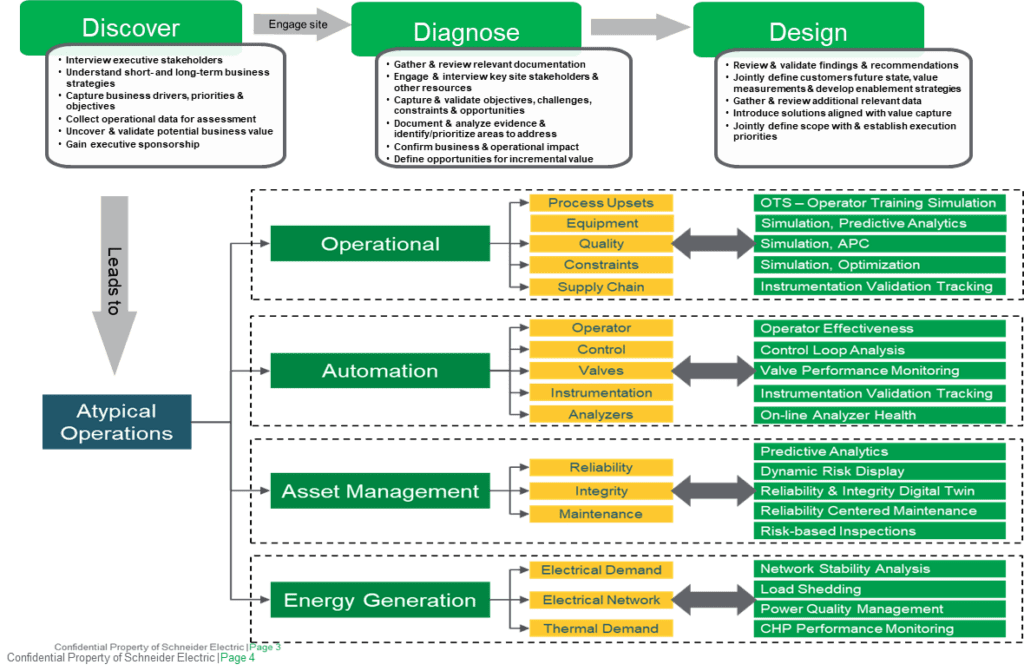By: Lanny Carr & Cory Welch
Operating companies are required to make informed investment decisions with confidence and with the least amount of effort. Investing in a robust GHG reduction study can be a substantial investment in both the money and time commitment of technical and operations personnel.
Schneider Electric is equipped to support its clients in making such a decision by performing a high-level energy screening and an initial assessment of the main causes of atypical high-energy operations.
For most petroleum-based operations there is always a one-to-one correspondence between energy reduction and CO2 reduction, except for where CO2 is produced as part of the process, e.g. SMR (steam-methane reforming to produce hydrogen) or where CO2 is part of the feed such in gas processing.
To perform an energy screening, hourly average operating data for all the products and energy sources are analyzed for a one to two years period. It is also useful to obtain operating data for other operating parameters, especially parameters that have a known impact on energy usage and GHG emissions; such as flaring, heater excess oxygen, large compressor inlet, outlet pressures, etc. The analysis of the operating parameters is useful to determine the extent to which such operating parameters impact energy usage.
As an output of the energy screening, a statistical regression is developed for operating rate and specific energy usage, as represented by the purple dashed trend line in Figure 1 below. Operations above the trend line are considered candidates for improvement, consider all operations above the line can be improved to coincide with the trend line; but not all operations above the trend line are candidates for improvement and, some operations could be improved to be below the trend.
The operating company should use its judgment as to which fraction of the operations above the trend line can be improved (this calculation is easily performed in Excel). In the example shown in Figure 1, a total of 8017 operating periods were considered of which 4899 were above the trend line. In the event that all of the operations can be improved to coincide with the trend line, energy savings of almost $1 million per year can be realized and resulting in a reduction of 30,500 tons of CO2 per year. In the event that a carbon tax or carbon credit applies, additional value can be realized from the CO2 reduction.

FIGURE 1
Periods of atypical operations or energy use are also identified by graphing the extent of the deviation above the trend line as shown in Figure 2 below. This allows for the focus to be on the operating periods that led to higher energy use and the associated causes of such operations. These atypical operations are then further decomposed as outlined in Figure 3 below.

FIGURE 2
The high-level energy screening and an initial assessment begin with key stakeholder interviews to gain an in-depth understanding of the customers’ short- and long-term strategies related to NetZero objectives and to capture the business drivers, and priorities aligned to these strategies. We’ll collect and assess operational data to assist in uncovering potential areas of incremental value aligned with their strategies and to gain agreement on which areas to explore in more detail depicted in Figure 1 and Figure 2 above.

FIGURE 3
The next step is to identify and interview key functional resources (Operations, Automation, Asset Management, Energy Generation) to capture a deeper understanding of possible causes of atypical operations and identify and document the business and operational impact. In this step we will also gather all related documentation and data for detailed analysis of each agreed area being explored, (e.g.: process block diagrams, PFDs, operating reports, time series data, operating modes, operational changes, etc.). The output of this effort is documented evidence of atypical operations which can then be used to identify, quantify, and prioritize opportunities for GHG reductions, profitably.
The final step of this process begins with the review and validation of our findings and recommendations with the customer’s stakeholders, introducing the customer to solutions that align with their priorities and jointly developing enablement strategies and/or solution roadmaps for each opportunity, focused on delivering the value identified and quantified.
For more information
To learn more about our consulting services please check out our e-book



